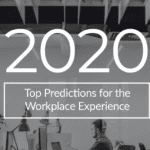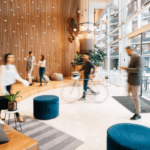
Top 5 Predictions for Workplace Experience in 2020
The way people work is fundamentally changing—how knowledge workers define a work station, the technology they use to interact with their physical surroundings, and how they choose to collaborate with colleagues—is rapidly evolving and posing new challenges for companies seeking to keep employees engaged and productive. As the industry’s leading workplace experience platform, Comfy regularly works with Fortune 1000 companies and emerging technology partners to anticipate and adapt to the changing workplace.
We asked our partners, clients, and in-house experts to weigh in on “what will the workplace look like in 2020?” Read on for a list of top 5 predictions.
1. Unassigned seating will become commonplace.
Less than 3 years ago, the practice of “hot desking” or unassigned seating was uncommon in North America and mostly limited to highly mobile job functions, like management consulting or sales. However, now thanks to the rise of remote working and changes in the way knowledge workers collaborate, companies across various industries are reimagining the modern workstation. Globally, Cushman & Wakefield’s latest “What Occupiers Want (WOW): Global Survey 2019” reports that 81% of corporate respondents indicated they are either introducing or testing agile workplace strategies, including desk sharing.
“Employees are interacting with the space differently than they did 10 to 15 years ago. Our people sit in our cafés to have meetings, they hop on a quick call in a quiet room, they have a meeting in an audio privacy room,” Julia Wright, Workplace Resources Manager of Cisco noted in a recent HOK report, “The desk as we know it is becoming less of a necessity within the office environment.”
2. Offices will become less dense, more effective, and more high-performing.
From 2009 to 2019, most companies have embraced office densification, consistently allocating less square footage per employee every year following the Great Recession. However, leading companies today are shifting the way they think about their real estate assets. Corporate real estate executives are talking about optimizing the use of their space by creating the “right mix” of personal, private, communal and break-out spaces.
“Workplaces cannot be designed in isolation. We need to listen to employees and take their requirements into consideration when planning workplaces,” said Matthias Grimm, VP of Global Real Estate & Facilities of SAP. “We expect them to do their best job and the least they can expect from us is to provide them with the best environment possible.”
“It’s about designing space that helps people be more productive, added Thomas Anderson, Product Manager, Real Estate Management of SAP. “Anybody can improve space utilization, but the key is to design space that improves utilization and still allows people to communicate, collaborate and concentrate well.”
3. Privacy worries, not technical capability, will be the reason for stagnation of smart offices.
When we asked our clients which types of workplace tech solutions will become table stakes by the end of 2020, the ability to cross share data (across BMS systems, edge controllers, and occupancy sensors) was referenced repeatedly. For good reason: advances in IoT technology have opened a realm of possibilities in data collection and workplace management analytics.
However, at Comfy we’ve witnessed first-hand how employee discomfort with sharing personal data can cause solution providers to slow down and find the sweet spot between privacy and transparency.
Comfy’s VP User Experience Beau Trincia recounted the process of developing our Coworkers feature, an opt-in interactive seating chart: “We ran surveys and interviews with hundreds of current Comfy users across all kinds of different workplaces. We started to see the disconnect between what corporate real estate leaders want and what employees are actually ready for. We quickly found that privacy is at the top of employees’ minds. When we tested location tracking via GPS or Bluetooth, a feature of interest to many corporate real estate leaders, employees were immediately uncomfortable.”
That’s why we made it easy for Comfy users to easily opt in to sharing their workspace address. No surprises. We’re taking a phased approach, keeping employees in control of their data while still solving their main problem: finding their coworkers in agile workspaces.
4. Businesses will continue to see a correlation between employee engagement and revenue growth.
According to MIT’s ‘Workplace Experience Drives Business Success,’ companies that were classified in the top quartile of employee experience developed more successful innovations, derived twice the amount of revenues from their innovations compared to companies in the bottom quartile, and their net promoter scores were twice as high.
Any way you slice it: higher employee engagement is correlated with higher revenue growth. We only expect to see this trend to continue and intensify in 2020 as our knowledge-based economy grows.
“The pressure C-suite executives face to stay competitive and deliver shareholder value relies on a simple challenge: How do we innovate more? How do we innovate faster? What spaces do we need to do so?” Daniel Schroeder, CEO of Comfy enthused. “Agile organizations work in rapid cycles of thinking and doing. They require physical and virtual environments that foster transparency, communication, and collaboration.”
5. Open platforms and strong partner integration will become a necessity.
Fifteen years ago it was hard to imagine all the future capabilities of the smartphone. Now, software developers around the world are releasing new apps to the App Store every hour. Like most leading SaaS companies, Comfy follows an agile software development methodology and continuously releases feature enhancements and updates every week. Point being: in today’s digital era, the value of emerging technology is not measured by its existing structural components or feature lists. Instead, today’s greatest technological advances are powerful because they are open, flexible, and interoperable with other systems. These are the technologies that will be equipped to meet evolving needs and agile enough to go beyond currently identified use cases.
As Elisa Rönkä, Business Development Innovation Manager, Siemens Smart Infrastructure summarized: “By equipping buildings with smart-ready technologies that are open for future integration and value creation, building owners and tenants can ensure that the digital readiness of a building persists over its life cycle.”
What do you think 2020 will have in store for the workplace experience? We’d be happy to talk with you about how to prepare for whatever the future may hold.
The brightest way to operate, orchestrate, and optimize everyday spaces.


